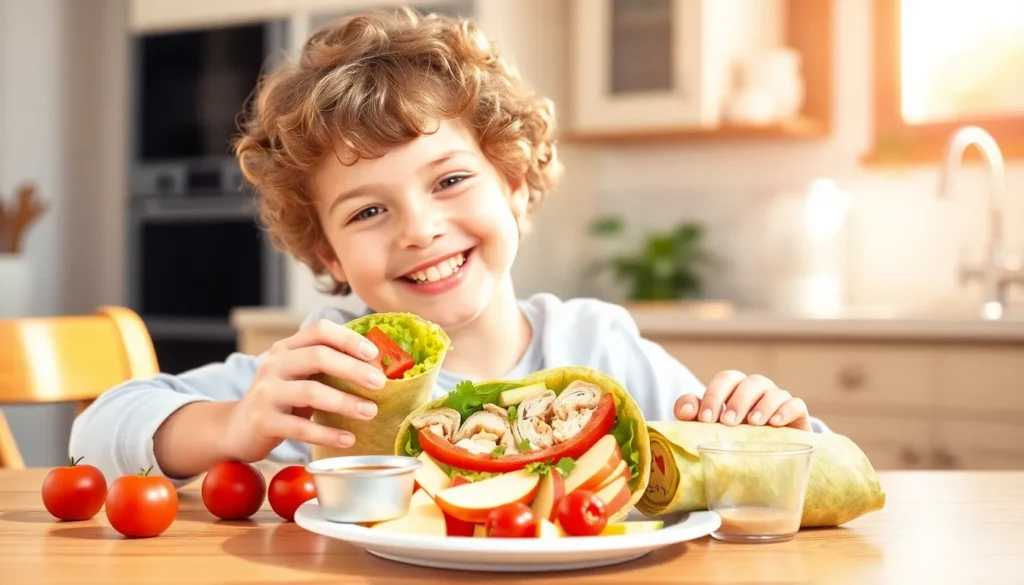Table of Contents
ToggleWhen it comes to packing lunches for kids, the struggle is real. Parents often find themselves in a daily battle against soggy sandwiches and uneaten veggies. But what if lunchtime could be a breeze instead of a chore? With a sprinkle of creativity and a dash of humor, easy kid lunches can transform from mundane to magical.
Easy Kid Lunches: A Comprehensive Guide
Variety helps keep kids interested in lunch. Incorporating different tastes and textures can make meals exciting. Packing whole grain wraps filled with turkey and cheese provides a nutritious option that kids often enjoy.
Fruits offer a refreshing touch. Sliced apples, berries, or oranges can brighten up the lunchbox, appealing to students’ sweet cravings while supplying essential vitamins. Consider pairing fruits with yogurt or nut butter for added flavor.
Vegetables don’t have to go untouched. Baby carrots, cherry tomatoes, and cucumber slices can create fun mini salads. Dipping sauces like hummus or ranch dressing can enhance appeal and encourage kids to munch on healthier choices.
Protein-rich snacks are filling and satisfying. Options include hard-boiled eggs, cheese sticks, or deli roll-ups. Each choice offers a boost of energy that supports children throughout their school day.
Easy-to-make mini sandwiches are versatile. Parents can use various spreads such as peanut butter, cream cheese, or hummus, layered with sliced cucumbers or strawberries. These combinations cater to diverse palates and keep lunchtime lively.
Incorporating leftovers can simplify lunch prep. Cold pizza, pasta, or grilled chicken can provide a quick and satisfying meal. When managed smartly, leftovers contribute to reducing food waste while keeping lunches exciting.
Finally, considering kids’ input works wonders. Allowing them to choose their favorites can make children more enthusiastic about eating what’s packed. Discussing options ahead of time fosters engagement and ownership of their lunch choices.
Nutritional Considerations

Packing nutritious lunches for kids requires attention to essential food groups and daily intake recommendations. Parents can ensure their children consume balanced meals while enjoying their favorites.
Essential Food Groups
Incorporating essential food groups into lunches promotes overall health. Include whole grains for energy, such as whole wheat wraps or brown rice. Fruits provide vital vitamins; examples like apples and berries boost immunity. Vegetables like baby carrots and cherry tomatoes offer fiber and nutrients; dips like hummus make them more appealing. Protein is crucial for growth, so options like turkey slices, hard-boiled eggs, and cheese sticks serve as ideal choices. Dairy products also contribute calcium for strong bones; low-fat yogurt can be a delicious addition to lunchboxes.
Recommended Daily Intake
Balancing daily food intake helps kids thrive. Ensure meals consist of 50% fruits and vegetables, encouraging consumption of a variety of colors. Add whole grains, aiming for at least 3 servings each day. Protein should account for about 10-30% of total calorie intake; selections can include beans, nuts, and lean meats. Dairy offers essential calcium; 2-3 servings daily support proper development. Planning meals based on these guidelines fosters healthy eating habits, setting a foundation for lifelong well-being.
Quick and Simple Recipes
Packing lunch doesn’t have to be complicated. Here are some easy recipes to keep lunchtime fresh and enjoyable.
Sandwich Ideas
Peanut butter and banana sandwiches offer a sweet twist that kids love. Cream cheese and cucumber sandwiches provide a crunchy, refreshing alternative. Ham and cheese sliders can be fun finger foods, easily packed in small portions. Turkey, lettuce, and tomato on whole grain bread create a classic favorite that’s both filling and nutritious. Kids appreciate variety, so consider adding a touch of honey or mustard to different sandwiches for additional flavor. Ensure to cut sandwiches into fun shapes for a playful presentation.
Wrap Variations
Whole grain wraps can be filled with a mix of turkey, cheese, and spinach for a nutritious option. Hummus and shredded carrots in a wrap create a colorful, tasty choice. Chicken salad with diced apples wrapped in a tortilla offers a sweet twist. For something different, try a breakfast wrap with scrambled eggs and avocado. Adding a layer of cheese can enhance flavor while keeping it appealing. Offering a range of fillings encourages children to participate in their meal choices.
Snack Plates
Snack plates allow for creativity and enjoyment during lunch. Combine cut fruits such as apples, grapes, and strawberries to keep things vibrant. Include an assortment of vegetables like cherry tomatoes, cucumber slices, and bell peppers paired with hummus or ranch dressing for dipping. Cheese cubes or string cheese provide a protein boost alongside whole grain crackers as crunchy companions. Incorporating nuts or yogurt can elevate the plate further. Kids appreciate variety, making snack plates a fun way to encourage healthy eating.
Creative Presentation Techniques
Creating appealing lunches encourages kids to enjoy their meals. Fun presentation can significantly transform a simple lunch into an exciting experience.
Fun Shapes and Designs
Using cookie cutters, parents can create fun shapes from sandwiches. Stars, hearts, and animals catch children’s attention and make food more inviting. Cutting fruits and vegetables into fun designs also adds visual appeal. For example, slicing apples into wedges or making cucumber flowers invites curiosity. Rolling up wraps tightly and slicing them into pinwheels offers a delightful surprise. Additionally, arranging food in a smiley face or themed characters on the plate can spark joy during lunchtime.
Colorful Ingredients
Bright ingredients attract kids and make healthy choices more appealing. Including various fruits and vegetables ensures a rainbow of colors on the plate. Strawberries, blueberries, and bell peppers not only enhance visual interest, but they also pack essential nutrients. Pairing cherry tomatoes with carrot sticks adds texture and contrasts in colors. Using whole grain wraps can complement vibrant fillings like spinach or roasted red peppers. Creative use of colorful ingredients invites kids to explore their meals and make healthy selections.
Tips for Meal Prep
Meal prep simplifies the lunch-packing process, ensuring kids enjoy varied meals daily.
Planning Ahead
Schedule a meal prep day weekly to streamline the process. Use this time to create a menu based on kids’ preferences. Choose recipes that incorporate essential food groups. Pre-portion snacks like cut veggies and fruits, ensuring convenience during busy mornings. Utilize leftovers creatively by transforming them into new dishes. Create a grocery list based on planned meals to avoid unnecessary purchases. Families can establish a routine, making lunch prep a collaborative effort.
Easy Storage Solutions
Select containers that are sectioned or bento-style for easier organization. Invest in reusable silicone bags for smaller snacks and to minimize waste. Utilize clear containers to quickly identify lunch items. Choose containers that are microwave-safe for easy reheating of leftovers. Label containers with the day’s date to monitor freshness. Stackable options maximize fridge space, ensuring efficient storage. Prioritize using durable materials that can withstand frequent use and cleaning.
Packing easy kid lunches doesn’t have to be a daunting task. With a little creativity and planning parents can transform lunchtime into a delightful experience. By incorporating a variety of nutritious options and involving kids in the process parents can ensure their children look forward to their meals.
Utilizing fun presentation techniques and colorful ingredients can make healthy choices more appealing. Meal prep strategies not only simplify lunch packing but also help establish healthy eating habits that can last a lifetime. Embracing these tips can lead to happier lunch hours and healthier kids ready to tackle their day.




